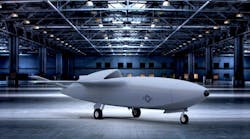The U.S. Air Force has awarded Voly Defense Solutions LLC (Concord, CA) an indefinite-delivery/indefinite-quantity (IDIQ) contract with shared ceiling of $400 million for the Skyborg Vanguard Program. The contract fuels experimentation, prototyping, and development of unmanned air vehicles (UAVs) for combination manned/unmanned missions. Multiple orders are covered by the contract with funding provided for each order. The contract, which is expected to be completed by July 2026, is being handled by Air Force Life Cycle Management at Wright Patterson Air Force Base in Ohio (FA8694-21-D-1400).
Skyborg vehicles (see figure) are low-cost UAVs designed in modular configurations that ease upgrades and improvements in hardware and software. The Air Force Research Laboratory (AFRL) is using the Skyborg Vanguard Program to work with other Department of Defense (DoD) service agencies to develop field-capable UAVs, integrating a variety of different technologies. For example, battlefield data collected by smaller UAVs will be combined with information gathered by military pilots to detect potential air and ground threats and their locations and identify options for defending against those threats. Advanced sensors backed by complex search algorithms provide the UAVs with the capabilities to make search-and-locate decisions compatible with rules of engagement set by pilots and crew in manned aircraft.
Because Air Force policy stipulates that humans are responsible for lethal decision-making, Skyborg aircraft will not replace the intelligence of human pilots. But they will provide data that can support quick, informed decisions in lethal scenarios. The Skyborg UAVs will operate as robotic companions to human pilots, increasing their survivability in dangerous situations.
